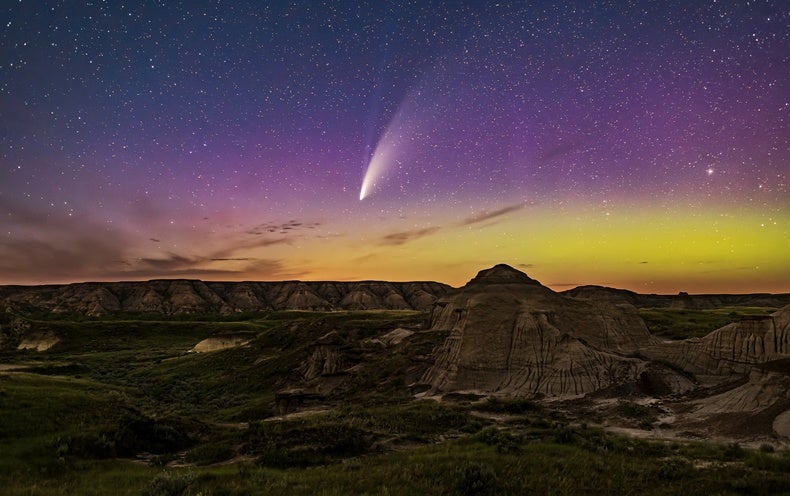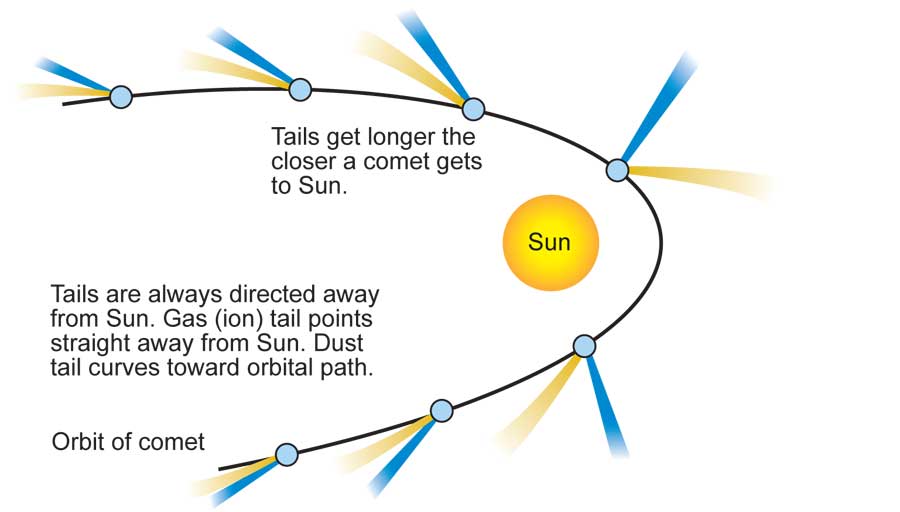- Feb 5, 2002
- 166,677
- 56,287
- Country
- United States
- Faith
- Catholic
- Marital Status
- Married
- Politics
- US-Others
Professional and amateur astronomers alike are hoping that Comet C/2023 A3 will sparkle in Earth’s skies in the fall of 2024, although comets are notoriously difficult to predict
Scientists and amateur astronomers are hot on the trail of what could be the next great comet.
It was just a faint speck seen through powerful telescopes on Earth when astronomers discovered Comet C/2023 A3, also known as Comet Tsuchinshan-ATLAS, earlier this year. But despite this object’s unassuming initial appearance, its orbit was immediately eye-catching: Comet Tsuchinshan-ATLAS is on track to zip quite close to the sun and Earth alike in the autumn of 2024, setting the stage for what could be a fantastic celestial spectacle.
“Pretty much right away, it started a buzz in the comet community, because predictions were putting it all over the place in terms of how bright it could get,” says Ariel Graykowski, a planetary astronomer at the SETI Institute in Mountain View, Calif. She says current estimates suggest that Comet Tsuchinshan-ATLAS may become brighter than Comet NEOWISE, which dazzled sky watchers in 2020, and that it could even rival Comet Hyakutake, which made a stunning close approach to Earth in 1996. The most optimistic projections forecast that the newfound comet could exceed even these notable forebears by becoming as bright as Venus.
But astronomers have been disappointed by plenty of promising comets that proved underwhelming, says Quanzhi Ye, a planetary astronomer at the University of Maryland, who describes himself as “cautiously excited” about Comet Tsuchinshan-ATLAS. “Comets are like cats: they have tails; they do what they want,” Ye says. “Almost for every case, it’s not going to end the way that you predicted.... We won’t know until we get there.”
Often described as dirty snowballs, comets are the dusty, icy relics of planetary formation that were hurled to the solar system’s outskirts eons ago by gravitational interactions with Jupiter or other giant worlds. Like old leftovers forgotten at the back of your freezer, they spend most of their time inert and unnoticed in the dark. But when one approaches the inner solar system, sunlight turns some of a comet’s ice into gas in a process called sublimation, forming a fuzzy, glowing cloud called a coma. Gas from the sunbathed, sublimating ice also puffs intermingled dust away from the surface to form a distinctive, comet-trailing tail.
Continued below.

 www.scientificamerican.com
www.scientificamerican.com
Scientists and amateur astronomers are hot on the trail of what could be the next great comet.
It was just a faint speck seen through powerful telescopes on Earth when astronomers discovered Comet C/2023 A3, also known as Comet Tsuchinshan-ATLAS, earlier this year. But despite this object’s unassuming initial appearance, its orbit was immediately eye-catching: Comet Tsuchinshan-ATLAS is on track to zip quite close to the sun and Earth alike in the autumn of 2024, setting the stage for what could be a fantastic celestial spectacle.
“Pretty much right away, it started a buzz in the comet community, because predictions were putting it all over the place in terms of how bright it could get,” says Ariel Graykowski, a planetary astronomer at the SETI Institute in Mountain View, Calif. She says current estimates suggest that Comet Tsuchinshan-ATLAS may become brighter than Comet NEOWISE, which dazzled sky watchers in 2020, and that it could even rival Comet Hyakutake, which made a stunning close approach to Earth in 1996. The most optimistic projections forecast that the newfound comet could exceed even these notable forebears by becoming as bright as Venus.
But astronomers have been disappointed by plenty of promising comets that proved underwhelming, says Quanzhi Ye, a planetary astronomer at the University of Maryland, who describes himself as “cautiously excited” about Comet Tsuchinshan-ATLAS. “Comets are like cats: they have tails; they do what they want,” Ye says. “Almost for every case, it’s not going to end the way that you predicted.... We won’t know until we get there.”
Often described as dirty snowballs, comets are the dusty, icy relics of planetary formation that were hurled to the solar system’s outskirts eons ago by gravitational interactions with Jupiter or other giant worlds. Like old leftovers forgotten at the back of your freezer, they spend most of their time inert and unnoticed in the dark. But when one approaches the inner solar system, sunlight turns some of a comet’s ice into gas in a process called sublimation, forming a fuzzy, glowing cloud called a coma. Gas from the sunbathed, sublimating ice also puffs intermingled dust away from the surface to form a distinctive, comet-trailing tail.
Continued below.

A Potentially Spectacular Comet Will Fly by Earth Next Year
Professional and amateur astronomers alike are hoping that Comet C/2023 A3 will sparkle in Earth’s skies in the fall of 2024, although comets are notoriously difficult to predict

